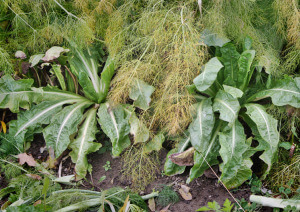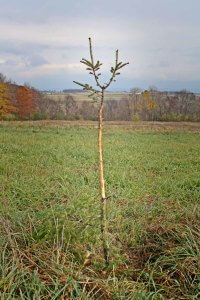Belgian Endives
One of the winter gardening projects that we are trying is Belgian Endive, also called witloof. The little football shaped heads, or chicons, are the end product of an extended growing process. The witloof seed are planted in spring and grow all summer, producing long carrot-like roots. The roots are harvested in the fall and put into cold storage. In the winter, the roots are potted in light soil or medium and put in a warm and dark location. This forces the roots to sprout, resulting in the nice tight chicon. Hopefully.
Witloof is a fairly close relative of the dandelion, so it was a bit weird pampering the “weeds” in one area and waging war on similar plants everywhere else. In November I dug the roots up. It was recommended to leave the roots in the field for several days to wither the foliage. It turns out that deer consider the roots to be quite a treat- they gnawed the ends off of all the roots. Where I had started with 10-12″ long slender roots, I ended up with 5″ or so nubbins.
The guide that I have said that 7″ roots are optimal, extra can be trimmed off. My four footed assistants were a bit overzealous, but I figured to work with the remains anyway. I also ended up trimming the tops a little tight, so the roots were damaged at both ends. Ahh well… this is an experiment, so the roots went into a plastic bag in the bottom of the ‘fridge, and we will see how they are in late December or early January.







